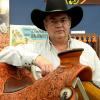Oops, forgot to address the cantle question. My first saddle, and most I've built since then, had a straight up cantle - no Cheyenne roll. Not only do I like the buckaroo look, but again, it eliminates several variables. Primarily, when you go to add the binding, you will find the corners VERY difficult to stitch, and even more difficult with a Cheyenne roll because you will be working in the blind for more of the time. I prefer a straight up cantle with a rawhide binding, but if I'm going to bind with leather, then I use a blind stitch so the back stitches don't show. When someone rides up behind you, that stitch line will scream at them if it is other than perfect, and it doesn't take more than one bad stitch to make it so.
I make with either a full leather seat or with a two-piece strainer, which I make. Both approaches have advantages,, but I don't find the use of leather to be necessarily too much heavier. I would caution you to stay away from rawhide though -- too fiddly for a beginner and takes too long to dry properly. I don't cut holes/slots for stirrup leathers, but take them into account while building the ground seat, so I don't have the problem that Sioux mentioned about scoring the rawhide.
If you think you are going to ride this saddle on your horses, then make a jig -- I can tell you how -- and send it to Arlen down at Bowden saddletree. He'll work with you to get it right, and if you need to go to a custom tree. the marginal cost is only about $35. If you want to take a flyer, just buy a tree that you like the looks of and use it as a learning tool,. If you've done quality work, you'll probably be able to sell it. But if you've done great work, you won't want to.





